Art and movement combine as figures seem to take on a life of their own, Wang Qian reports.
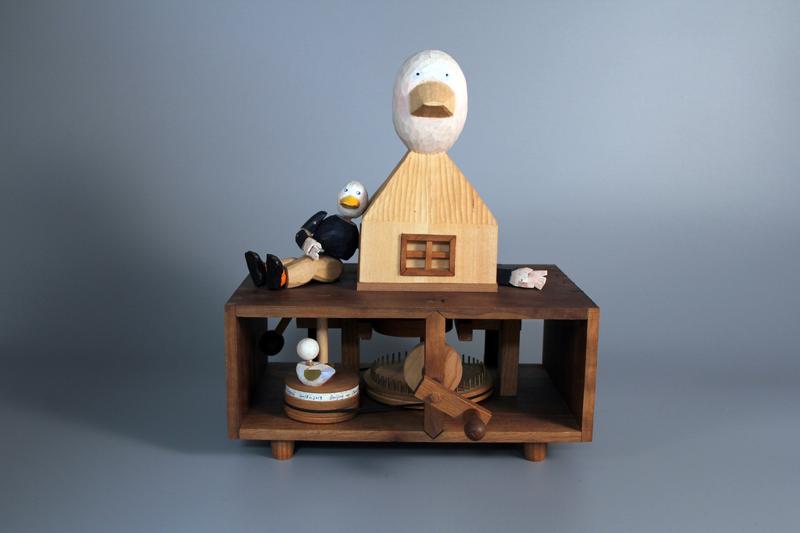 One of automata maker Yu Chenrui's works, titled Search for Self, depicts a duck contemplating the play of a carefree duckling. The artist aims to convey the essence of people's lifelong search for meaning in their own lives, their innocent happiness as well as the doubts that come with age. (PHOTO PROVIDED TO CHINA DAILY)
One of automata maker Yu Chenrui's works, titled Search for Self, depicts a duck contemplating the play of a carefree duckling. The artist aims to convey the essence of people's lifelong search for meaning in their own lives, their innocent happiness as well as the doubts that come with age. (PHOTO PROVIDED TO CHINA DAILY)
Under the creative influence of Yu Chenrui, wood not only comes alive, it also tells incredible stories and draws an appreciative audience.
With the crank of a handle, the push of a button or the tug of a string, wooden figures in his creations move as if by magic. Yu, 29, is a maker of automata, self-propelled, artistic mechanical figures, in Chengdu, Sichuan province. Automata are built to look like humans or animals and give the illusion of being able to move on their own.
"The art form amazes me, because it integrates various skills, from storytelling to mechanics, and the pieces are built with a sense of humor," Yu says.
In an age of technology, this is undoubtedly a marginal sector. Yu estimates that it has attracted no more than 10 full-time makers and practitioners across the country. His creations have caught the attention of renowned artists, such as Paul Spooner from the home of automata making in the United Kingdom and Kazuaki Harada from Japan.
On social media, Spooner applauded Yu as "a great practitioner". In February, Kazuaki recommended him for the Automata Program during this year's World Wood Day, which fell on March 21, to spotlight and bring awareness to the importance and cultural value of wood and its responsible uses.
With prices ranging from hundreds to tens of thousands of yuan, his whimsical pieces of art have attracted collectors worldwide.
"A fascinating thing about automata is that it delights people of all ages. Adults appreciate them as art, while children see them as toys to be played with," Yu says, smiling.
The automata story has its origins in ancient Greece. Indeed, the name comes from the Greek word automatos, meaning "moves on its own".Automata were the first complex machines produced by man, and the mechanical principles applied haven't changed for thousands of years.
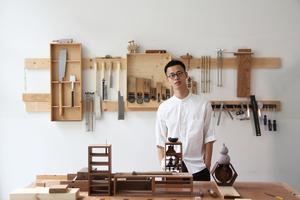 Yu Chenrui with his many woodworking tools at his studio in Chengdu, Sichuan province. (PHOTO PROVIDED TO CHINA DAILY)
Yu Chenrui with his many woodworking tools at his studio in Chengdu, Sichuan province. (PHOTO PROVIDED TO CHINA DAILY)
Going against the grain
Interested in handcrafts as a boy, Yu first encountered automata designed by Kazuaki at an exhibition in 2015 when he studied at the Communication University of China in Beijing. "It was like meeting a like-minded friend," Yu says, recalling the moment.
As an art and design major, he began to learn the craft by himself and, with the support of his tutor Lu Ying, he kept studying and examining automata in school. Now the hobby has become a career.
The pieces that seem to move effortlessly take a beginner a long time to make. It can take Yu more than a year to ensure his mechanical sculptures move smoothly.
When he graduated in 2016, Yu landed a job at an advertising agency near Shichahai, a popular scenic area in Beijing. He stayed on at the company for three years because, at that time, he was not sure that he could make a living out of his hobby.
While working as a designer, Yu kept exploring and advancing his skills in wood carving and mechanics. Eventually, though, despite the job's good salary, it was not enough to compensate for not following his true passion. Every day, when he walked alone along the Shichahai lake, he watched ducks swimming, foraging and diving. He envied, in a way, their freedom to do as they pleased.
"Every time I would encounter the ducks, I would ask myself if I was doing what I wanted, and if I was happy with my life," Yu remembers.
The ducks inspired his automaton creation entitled Search for Self, in which a duckling swims happily in a circle. At the same time, an older duck seems unsure of what its life is about. The younger bird seems unconcerned, and is just happy to play.
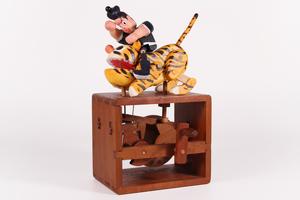 Wu Song Beats the Tiger. (PHOTO PROVIDED TO CHINA DAILY)
Wu Song Beats the Tiger. (PHOTO PROVIDED TO CHINA DAILY)
At an exhibition, when a girl saw the piece and asked why the duck kept searching but finding nothing, Yu heard her grandmother's interpretation, which of course was exactly how he wanted the piece to be explained. The grandmother said that, because humans change as time goes by, searching for yourself is a lifelong process, and doubts may come with age.
Finally, in 2018, Yu quit his job and returned to Chengdu to open his automata workshop. The studio he rents exceeds 200 square meters, and Yu has spent more than 300,000 yuan (US$46,000) refurbishing it.
Just after finishing the renovation, Yu didn't know what to do and worried about cash flow. To keep himself occupied he planted blueberries, raspberries and cherries. He watered, weeded and added fertilizer every day.
"Daily routines helped me calm down and reignited my creativity, which resulted in an automaton called To Observe the Autumn," Yu says. The pendulum installation tries to show how lovely and short autumn is.
The planting and distractions seemed to work as word spread among the city residents and business increased.
Many of Yu's creations are built with a dash of wisdom, a sprinkle of humor and are inspired by observations of real life.
Woodcutter and Worm is derived from his own experience of finding a wormhole while cutting wood. The piece shows a creature with its eyes wide open at the moment the log in which it lives is being cut in two.
One fan, Paul James, who saw the piece online commented: "Amazing woodwork, really love the small details, like the fingers moving individually on a hand and the worm hidden inside the wood log."
Yu knows that there are many more creative ideas waiting to be expressed. "It feels quite good to be fully devoted to automata creation and I am still searching for myself."
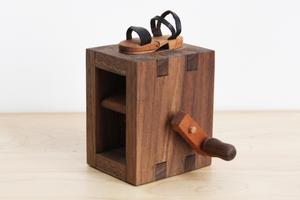 Broken Sandal. (PHOTO PROVIDED TO CHINA DAILY)
Broken Sandal. (PHOTO PROVIDED TO CHINA DAILY)
A moving past
The ancient Greeks provided the earliest examples of automata. Greek mythology was influenced by the possibility of immortality and creating artificial life. Ancient cultures, such as China and Rome, have also preserved automata in writings, drawings and paintings.
The earliest surviving full-length book of Greek robots is by mathematician and engineer Heron of Alexandria. He actually designed automata-machines operated by mechanical or pneumatic means. These included devices for temples to instill faith by deceiving believers with "magical acts of the gods", for theatrical spectacle, and machines like a statue that poured wine.
Chinese carpenter Lu Ban, about 2,000 years ago, used rubber bands as a power source to make a wooden bird fly. Besides the imitation of animals, automata have a long connection to horology and clock manufacture.
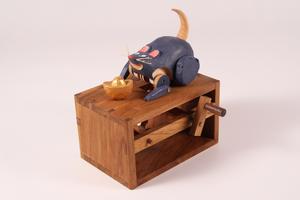 Goldy Mouse. (PHOTO PROVIDED TO CHINA DAILY)
Goldy Mouse. (PHOTO PROVIDED TO CHINA DAILY)
According to Gods and Robots: Myths, Machines, and Ancient Dreams of Technology by Adrienne Mayor, some of today's most advanced innovations in robotics and artificial intelligence were foreshadowed by the invention of ancient animated machines, like automata.
"I take automata as an ancient and traditional technology," Yu says, adding that traditional structures, like sunmao, meaning wood tenons and joints, have their advantages, such as stability. Such structural elements are among the oldest and most durable techniques applied in Chinese architecture throughout history.
Although the origin of automata dates back thousands of years, Yu doesn't reject applying modern techniques.
"Modern technology makes mass production of my automata possible, which can make the art form more popular and allow it to be enjoyed by more people," he says. After another one or two years weighing up the possibilities in automata creation, he hopes his plans for mass production can be realized.
Late last year, he made a cycling machine for the Community Art Project in Chengdu. It uses pedal power to manipulate clog wheels that "fire" tennis ball-sized objects.
"I hope it can be enjoyed by people of all ages, and makes them feel more connected and happier," Yu says.
Contact the writer at wangqian@chinadaily.com.cn


